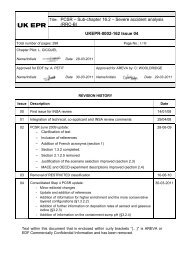Level 3 PSA - EDF Hinkley Point
Level 3 PSA - EDF Hinkley Point
Level 3 PSA - EDF Hinkley Point
Create successful ePaper yourself
Turn your PDF publications into a flip-book with our unique Google optimized e-Paper software.
HPC-NNBOSL-U0-000-RES-000028 Version 1.0<br />
<strong>Level</strong> 3 <strong>PSA</strong><br />
NOT PROTECTIVELY MARKED<br />
CF<br />
= the dose risk conversion factor which is 5x10-2 Sv-1 for all dose bands other<br />
than dose band 5 where a probability of death is assumed to be 1; i.e. for<br />
DB5 (WDB x CF) = 1.<br />
The list of Worker Release Categories together with the Dose Band allocation is shown<br />
in Table 23.<br />
Not all WRCs identified in Table 23 are used in the risk analysis because although they<br />
represent credible accident scenarios, they currently do not have any accident<br />
sequences associated with them.<br />
5.5 Worker Cohorts<br />
To gain a better understanding of the distribution of risk, three worker profiles or ‘cohorts’<br />
have been defined as follows:<br />
<br />
A generic worker - for the overall comparison against SDO-4, a generic worker profile<br />
has been used. This profile assumes that there is a hypothetical individual worker<br />
who could be present in any building on site when an accident occurs. The risk to<br />
this worker from accidents in each building is therefore calculated taking into account<br />
the probability (i.e. occupancy factor) that the worker would be in this building when<br />
the accident takes place.<br />
A Fuel Building worker – this worker profile represents a worker who spends all of<br />
their time when on site carrying out fuel building operations [AS-012]. This group<br />
therefore has a maximum risk of exposure to accidents in the fuel building, in<br />
particular fuel handling accidents, and a negligible exposure to accidents occurring in<br />
other buildings. This cohort represents the bounding case for all workers involved in<br />
controlled processes such as lifting operations, where the occupancy factor is taken<br />
as unity, whilst still representing a realistic worker group.<br />
A Main Control Room (MCR) worker – this worker profile represents a worker who<br />
has to remain present in the MCR throughout the duration of an accident anywhere<br />
on site [AS-013]. This worker group therefore has the maximum risk of exposure to<br />
the consequences in the MCR of all accidents which result in an external (on-site)<br />
release, including severe accidents.<br />
In addition, although not technically a separate worker cohort, the risk arising from the<br />
performance of LOSAs has been evaluated separately. This risk represents the risk to<br />
any individual worker if any accident requiring a LOSA occurs whilst they are on site and<br />
they are required to perform the LOSA. The results of the worker Risk Analysis for all<br />
worker cohorts, with and without the contribution from LOSAs, are presented in Sections<br />
5.6.3 and 5.6.4.<br />
UNCONTROLLED WHEN PRINTED<br />
NOT PROTECTIVELY MARKED<br />
Page 24 of 60














![6.3 - Safety Injection System (RIS [SIS]) - EDF Hinkley Point](https://img.yumpu.com/42739985/1/184x260/63-safety-injection-system-ris-sis-edf-hinkley-point.jpg?quality=85)


